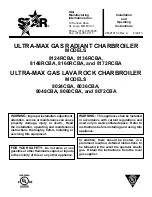
LAARS Heating Systems
Page 78
control to Manual, this forces the burner to run
at full combustion so you can adjust the gas
valve for the correct CO
2
output.
Figure 100 shows the adjusting points on the
gas valve. Adjust the High Fire screw to get
the proper CO
2
level for high fire. See Table
17. To raise the high fire CO
2
level, turn the
High Fire adjustment screw counter-clockwise.
To lower the high fire CO
2
level, turn the screw
clockwise.
(Make the adjustment in small steps of 1/8 turn
to avoid “overshooting” the correct setting.
The valve is built with a bit of “backlash.”
This makes it appear that changing the
adjustment does not change the CO
2
level
when you first stop turning the control in one
direction, and start turning it the other way.
Once the backlash has been taken up, the
control will be quite sensitive.)
13. Repeat steps 10 through 12, except this time
set the fan speed RPM to 1200rpm. (Again, the
actual RPM will not go this low – the control
will limit the fan speed to the minimum set
at the factory.) This will force the boiler to
operate in low fire. Adjust the Low Fire screw
so the CO
2
is 0.5% lower than the high fire
CO
2
. To raise the low fire CO
2
, turn the Low
Fire adjustment screw clockwise. To lower the
low fire CO
2
, turn the screw counter-clockwise.
14. The adjustment you made for the Low Fire
setting could affect the High Fire setting, so
you need to re-check the High Fire setting. Go
back to the Operations screen and set the Firing
Rate back to 6500 RPM. The CO
2
should
still be about at the level listed in Table 17. If
the CO
2
is not correct, repeat the steps listed
above.
15. Set the Firing Rate back to 1200 RPM, and re-
check the CO
2
during Low Fire.
16. Once the CO
2
values are correct for both High
Fire and Low Fire, go back to the Operation
screen and select Automatic operation. At this
point, you have set up the Primary burner for
this boiler.
17. Now you can do the same setup for the
Secondary burner on this boiler. To do this,
you need to shut off the Primary burner. On
the Secondary control, you set the High and
Low Fire RPM and check the CO
2
output for
each condition. We will review the process
quickly here:
• On the Home screen, press the icon for the
Secondary controller.
• On the Status Summary screen, press the
Operation button.
• On the Operation screen, press the Login
button and login using the installer-level
password, then press OK.
• Now you can change the Firing Rate RPM for
the Secondary burner. Enter 6500 RPM for the
High Fire value. On the left side of the screen,
in the space for Normal Setpoint, select Manual
and press OK. Adjust the High Fire screw to
get the CO
2
level listed in Table 17.
• Set the fan speed RPM to 1200rpm. Adjust
the Low Fire screw so the CO
2
level reaches the
CO
2
level listed in Table 17.
• Re-check the High Fire setting at 6500 RPM.
The CO
2
should still be about 8.5%.
• Re-check the CO
2
during Low Fire at 1200
RPM.
• Once the CO
2
values are correct for both High
Fire and Low Fire, go back to the Operation
screen and select Automatic operation. At this
point, you have set up the Secondary burner for
this boiler.
• Go back to the Home screen and press the
icon for the Primary control. On the Status
Summary screen, press the Operation button.
On the Operation screen, press the Burner
button to turn on the Primary burner.
18. Once both burners are set up properly, operate
both burners together as described below, and
check the CO
2
levels with the unit operating at
high fire and at low fire. The final CO
2
values
at high fire should be as listed in Table 17
±0.2%. At low fire, the CO
2
should be about
0.5% lower than the high fire CO
2
reading. (The
offset is more important than the actual CO
2
value)
Monitor the CO
2
and CO levels for one
complete operating cycle. The CO should
never be more than 150 ppm. The CO
2
level
should also track between the high and low
limits listed in the table.
Setting the fan speed RPMs for both burners
operating together -
• It is important that both burners operate at
the same fan speed. Before changing the fan
speeds, turn off the call for heat.
• Set the fan speed for each burner separately,
using the procedure we described earlier - steps
6 though 10 for the Primary burner, and step 17
for the Secondary burner. On each burner, enter
a value of 6500 RPM for the high fire test.
• Once you have set both burners to run at
6500 RPM, turn on the call for heat, and check
the results as described above.
Summary of Contents for NTV1000
Page 2: ......
Page 35: ...NeoTherm Boilers and Water Heaters Page 31 Fig 20 Ladder Diagram...
Page 36: ...LAARS Heating Systems Page 32 Fig 21 Wiring Diagram...
Page 37: ...NeoTherm Boilers and Water Heaters Page 33...
Page 51: ...NeoTherm Boilers and Water Heaters Page 47 Fig 52 Connection Terminals...
Page 130: ...LAARS Heating Systems Page 126 Fig 140 Machine Frame and Rear Panel 13 3 PARTS ILLUSTRATIONS...
Page 131: ...NeoTherm Boilers and Water Heaters Page 127 Fig 141 Front Panel and Covers...
Page 132: ...LAARS Heating Systems Page 128 Fig 142 Burners and Combustion Chambers...
Page 134: ...LAARS Heating Systems Page 130 Fig 145 Electronic Components...
Page 135: ...NeoTherm Boilers and Water Heaters Page 131 Fig 146 Condensate Trap Fig 147 Control Bezel...
Page 136: ...LAARS Heating Systems Page 132 Fig 148 Flow Switch...
Page 137: ...NeoTherm Boilers and Water Heaters Page 133 This page intentionally left blank...
















































